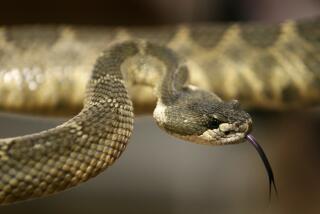Six myths about rattlesnakes, busted

Rattlesnakes are part of life in Southern California, but there are a lot of misconceptions about our slithering friends. These are some of the most common myths, broken down.
Baby rattlesnakes are more dangerous than adults.
Not really. It’s a myth that baby rattlesnakes release more venom than adults, said UC Davis conservation biology professor Brian Todd.
In fact, babies are typically less dangerous because they have less venom to inject when they bite, Todd said.
Younger snakes can be more hazardous because they’re small and hard to see, and because they are born without a rattle. The rattle grows each time the snake sheds its skin, so a baby rattler may not have shed enough times to give a warning before striking, Todd said.
Snake-removal services sprang up because of a desire to tame nature, but the rattlers thrive just the same. Says one wrangler: “We build our homes on their homes, we just build nicer ones.”
People are either born with a fear of snakes or they’re not.
Fifty-one percent of Americans fear snakes — a fear more common than public speaking, heights and flying, according to a Gallup poll from 2001, the last time the organization surveyed people’s fears.
Studies have found that infants and monkeys react differently to snakes than to other animals. One study found that 6-month-old infants’ pupils widened when they saw images of snakes, compared with images of fish, suggesting that humans are primed to fear snakes.
But studies have determined that humans respond unusually, not necessarily fearfully, to snakes. Many scientists believe our brains evolved to understand there’s something special about snakes, but that priming doesn’t develop into full-blown fear without some influence from our environment.
Snakes are depicted as scary in movies and other media, and children may begin to associate those ideas with the animals. Children may also pick up cues from parents who sound fearful around snakes, experts say. The creatures also move unlike any other creature on the planet, making them easy targets for disgust and fear, said Vanessa LoBue, a psychology professor at Rutgers University.
“You do hear a lot of threatening information about snakes, so maybe it’s not super, super surprising that lots of people develop a fear of them,” she said. “There’s a lot of things working against them.”
Rattlesnakes always rattle before striking.
Not always. Rattlesnakes taken by surprise may bite without rattling first, Todd said.
“They prefer to only bite their dinner, so they often warn,” Todd said. “But if you don’t give them the chance, they will defend themselves.”
Though some have posited that rattlers are evolving away from rattling as the noisier snakes are killed and quieter ones survive, experts say that is a myth.
“That notion has been around a long time, at least decades, and in various guises.... But I know of no evidence for any truth to such stories,” said Cornell University emeritus ecology professor Harry Greene in an email.
Snakes love heat.
Snakes will emerge from hiding when the sun comes out, but their inability to regulate their body temperature means they can’t handle much heat. They move constantly to seek out temperatures between 70 and 90 degrees, Todd said. Local rattlesnakes can die if they spent more than 10 minutes in extreme heat, experts say.
“They like the temperatures we like,” said Southern California snake expert Bo Slyapich. “When we go in the shade, they go in the shade.”
Slyapich added that if people can comfortably hang out outside in a T-shirt at night, snakes are probably out then too.
We asked for your best snake story. Dozens of you came at us with your favorite (or most harrowing) encounters.
If I trap a snake in my house or backyard, it will die without water or food.
Technically, yes, but not as quickly as you’d like. Snakes can survive several months, even years, without food, experts say.
When scientists deprived a group of snakes, including rattlesnakes, of food for six months, the snakes reduced their metabolic rate by as much as 72% to conserve energy, according to a 2007 study in the journal Zoology. During that time, the snakes continue to grow longer, the study found.
A rattlesnake bite will kill me.
Rattlesnake bites can be fatal, but rarely. Between 7,000 and 8,000 people per year are bitten by venomous snakes in the United States, but only five of them die each year, according to the Centers for Disease Control and Prevention.
In 10% to 20% of rattlesnake bites, the creatures do not release venom, probably because they don’t see the human as prey, said Dr. Cyrus Rangan, assistant director with the California Poison Control System.
In venomous bites, a victim’s chance of surviving can drop if they have an allergic reaction to the venom, or if a fang reaches directly into a vein or artery, sending the poison flowing throughout their body, he said.
Most commonly, snake bite victims are men between 18 and 25 years old who are intoxicated and “doing something very stupid,” like trying to pick up the snake, Rangan said.
Todd said the snakes usually aren’t to blame: “Apparently the real issue is testosterone poisoning or alcohol use, not the snakes themselves.”
More to Read
Sign up for Essential California
The most important California stories and recommendations in your inbox every morning.
You may occasionally receive promotional content from the Los Angeles Times.












